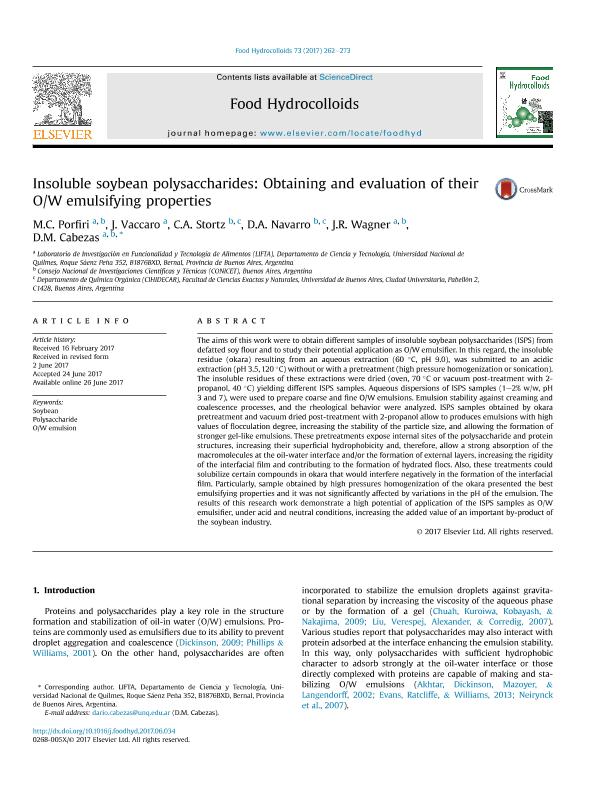Mostrar el registro sencillo del ítem
dc.contributor.author
Porfiri, María Cecilia

dc.contributor.author
Vaccaro, J.
dc.contributor.author
Stortz, Carlos Arturo

dc.contributor.author
Navarro, Diego Alberto

dc.contributor.author
Wagner, Jorge Ricardo

dc.contributor.author
Cabezas, Dario Marcelino

dc.date.available
2018-04-06T17:55:15Z
dc.date.issued
2017-12
dc.identifier.citation
Porfiri, María Cecilia; Vaccaro, J.; Stortz, Carlos Arturo; Navarro, Diego Alberto; Wagner, Jorge Ricardo; et al.; Insoluble soybean polysaccharides: Obtaining and evaluation of their O/W emulsifying properties; Elsevier; Food Hydrocolloids; 73; 12-2017; 262-273
dc.identifier.issn
0268-005X
dc.identifier.uri
http://hdl.handle.net/11336/41188
dc.description.abstract
The aims of this work were to obtain different samples of insoluble soybean polysaccharides (ISPS) from defatted soy flour and to study their potential application as O/W emulsifier. In this regard, the insoluble residue (okara) resulting from an aqueous extraction (60 °C, pH 9.0), was submitted to an acidic extraction (pH 3.5, 120 °C) without or with a pretreatment (high pressure homogenization or sonication treatment). The insoluble residues of these extractions were dried (oven, 70 °C or vacuum post-treatment with 2-propanol, 40 °C) yielding different ISPS samples. Aqueous dispersions of ISPS samples (1?2% w/w, pH 3 and 7), were used to prepare coarse and fine O/W emulsions. Emulsion stability against creaming and coalescence processes, and the rheological behavior were analyzed. ISPS samples obtained by okara pretreatment and vacuum dried post-treatment with 2-propanol allow to produces emulsions with high values of flocculation degree, increasing the stability of the particle size, and allowing the formation of stronger gel-like emulsions. These pretreatments expose internal sites of the polysaccharide and protein structures, increasing their superficial hydrophobicity and, therefore, allow a strong absorption of the macromolecules at the oil-water interface and/or the formation of external layers, increasing the rigidity of the interfacial film and contributing to the formation of hydrated flocs, Also, these treatments could solubilize certain compounds in okara that would interfere negatively in the formation of the interfacial film. Particularly, sample obtained by high pressures homogenization of the okara presented the best emulsifying properties and it was not significantly affected by variations in the pH of the emulsion. The results of this research work demonstrate a high potential of application of the ISPS samples as O/W emulsifier, under acid and neutral conditions, increasing the added value of an important by-product of the soybean industry.
dc.format
application/pdf
dc.language.iso
eng
dc.publisher
Elsevier

dc.rights
info:eu-repo/semantics/openAccess
dc.rights.uri
https://creativecommons.org/licenses/by-nc-nd/2.5/ar/
dc.subject
O/W EMULSION
dc.subject
POLYSACCHARIDE
dc.subject
SOYBEAN
dc.subject.classification
Alimentos y Bebidas

dc.subject.classification
Otras Ingenierías y Tecnologías

dc.subject.classification
INGENIERÍAS Y TECNOLOGÍAS

dc.title
Insoluble soybean polysaccharides: Obtaining and evaluation of their O/W emulsifying properties
dc.type
info:eu-repo/semantics/article
dc.type
info:ar-repo/semantics/artículo
dc.type
info:eu-repo/semantics/publishedVersion
dc.date.updated
2018-04-06T14:10:03Z
dc.journal.volume
73
dc.journal.pagination
262-273
dc.journal.pais
Países Bajos

dc.journal.ciudad
Amsterdam
dc.description.fil
Fil: Porfiri, María Cecilia. Consejo Nacional de Investigaciones Científicas y Técnicas; Argentina. Universidad Nacional de Quilmes. Departamento de Ciencia y Tecnología. Laboratorio de Investigación en Funcionalidad y Tecnología de Alimentos; Argentina
dc.description.fil
Fil: Vaccaro, J.. Universidad Nacional de Quilmes. Departamento de Ciencia y Tecnología. Laboratorio de Investigación en Funcionalidad y Tecnología de Alimentos; Argentina
dc.description.fil
Fil: Stortz, Carlos Arturo. Consejo Nacional de Investigaciones Científicas y Técnicas. Oficina de Coordinación Administrativa Ciudad Universitaria. Centro de Investigaciones en Hidratos de Carbono. Universidad de Buenos Aires. Facultad de Ciencias Exactas y Naturales. Centro de Investigaciones en Hidratos de Carbono; Argentina
dc.description.fil
Fil: Navarro, Diego Alberto. Consejo Nacional de Investigaciones Científicas y Técnicas. Oficina de Coordinación Administrativa Ciudad Universitaria. Centro de Investigaciones en Hidratos de Carbono. Universidad de Buenos Aires. Facultad de Ciencias Exactas y Naturales. Centro de Investigaciones en Hidratos de Carbono; Argentina
dc.description.fil
Fil: Wagner, Jorge Ricardo. Consejo Nacional de Investigaciones Científicas y Técnicas; Argentina. Universidad Nacional de Quilmes. Departamento de Ciencia y Tecnología. Laboratorio de Investigación en Funcionalidad y Tecnología de Alimentos; Argentina
dc.description.fil
Fil: Cabezas, Dario Marcelino. Consejo Nacional de Investigaciones Científicas y Técnicas; Argentina. Universidad Nacional de Quilmes. Departamento de Ciencia y Tecnología. Laboratorio de Investigación en Funcionalidad y Tecnología de Alimentos; Argentina
dc.journal.title
Food Hydrocolloids

dc.relation.alternativeid
info:eu-repo/semantics/altIdentifier/doi/http://dx.doi.org/10.1016/j.foodhyd.2017.06.034
dc.relation.alternativeid
info:eu-repo/semantics/altIdentifier/url/https://www.sciencedirect.com/science/article/pii/S0268005X17302771
Archivos asociados
